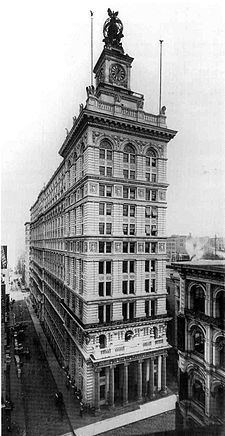Built 1894 Designated NYCL February 10, 1987 Added to NRHP 28 June 1982 | NRHP Reference # 82003376 Opened 1894 | |
 | ||
Location 346 Broadway, New York, New York Architect Stephen D. Hatch; McKim, Mead & White Architectural style Late 19th And 20th Century Revivals Similar New York Life Building, Metropolitan Life Tower, A T Stewart Company, Puck Building, 23 Wall Street | ||
The Former New York Life Insurance Company Building, also known as the Clock Tower Building, is an office building located at 346 Broadway (with a secondary address of 108 Leonard Street) between Catherine Lane and Leonard Street, in Manhattan, New York City. Built in two stages, from 1868 to 1870 and from 1894 to 1899, it is a New York City Landmark and is listed on the U.S. National Register of Historic Places.
History
The New York Life Insurance Company's headquarters building was originally built in 1868-1870. It needed to be expanded eastward to Lafayette Street and Stephen Decatur Hatch was engaged for the job. Hatch designed the extension, but died before construction could be completed. The firm of McKim, Mead & White took over the work, and completed the extension in 1894, following Hatch's design. The company then decided to replace the original building as well, and McKim, Mead & White provided an Italian Renaissance Revival style "palazzo-like" design with a clock tower whose clock was manufactured and installed by the E. Howard Clock Company.
New York Life left for the New York Life Building on Madison Square Park in 1928. In 1967, the City of New York acquired the building and moved several city agencies along with the Criminal Court, Summons Part there. The city retained use of the building until the early 2010s, when it sold the building.
The building was added to the National Register of Historic Places in 1982, and both the exterior and interior were designated New York City landmarks in 1987 by the New York City Landmarks Preservation Commission. The building is also included in the AIA Guide to New York City.
In January, 2012 workers began scaffolding the clock tower section above the building (around the actual clock). At this point the metal sculpture seen sitting above the clock in older photos is no longer in place.
In 2015, the El Ad Group and Peebles Corporation made plans to convert the landmark to a private apartment. The clock mechanisms and faces were to be preserved. The plan, which included converting the clock to electrical operations, was granted a certificate of appropriateness by the landmark commission. Opponents, including Save America’s Clocks, filed a lawsuit to stop the conversion. One of the primary reasons cited is that it is one New York City’s few remaining mechanical clock towers, and a designated landmark.
On March 31, 2016 Justice Lynn R. Kotler, of New York State Supreme Court revoked the certificate of appropriateness. According to the ruling, the landmark commission has to power to require the building owner to maintain the mechanical mechanism, and to issue a violation if the clock is transitioned to electrical workings.
